Edakkal Caves
Edakkal Caves also Edakal[1][2], are two natural caves at Edakkal, in Wayanad district of Kerala. The caves are situated 1,200 m (3,900 ft) above sea level on Ambukutty Mala, on the Mysore Plateau, in the Western Ghats.
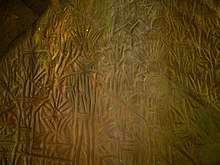    | |
 Location in India | |
| Location | Wayanad district, Kerala |
|---|---|
| Region | India |
| Coordinates | 11°37′28.81″N 76°14′8.88″E |
| Site notes | |
| Discovered | Fred Fawcett (1890) |
| Part of a series on the |
| History of Kerala |
|---|
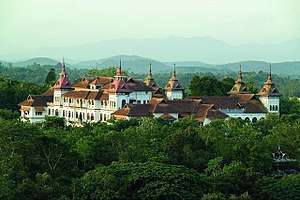 |
|
Main Megalithic culture Maritime contacts |
|
Other topics |
|
The Edakkal caves are believed to be camping shelters of the Neolithic community (the south Indian Neolithic culture zone). The cave walls contain a collection of Neolithic rock engravings and images (which were incised over a period of time). The major part of images on the cave walls may belong to late Neolithic period (i. e., first millennium BC).[1] With the exception of Edakkal, no concrete evidence for the existence of a true Neolithic culture in Kerala has so far been discovered.[1]
The caves were discovered by Fred Fawcett, Superintendent of Police, Malabar District in 1896[2] who immediately recognised their anthropological and historical importance. He published an article (1901) about the caves in the Indian Antiquary (Volume 30), attracting the attention of scholars.[2]
The caverns at Edakkal are not technically caves, but rather a cleft, rift or rock shelter approximately 96 ft (29 m) by 22 ft (6.7 m), a 30-foot-deep (9.1 m) fissure caused by a piece of rock splitting away from the main body. On one side of the cleft is a rock weighing several tons that covers the cleft to form the "roof" of the cave.
Image gallery
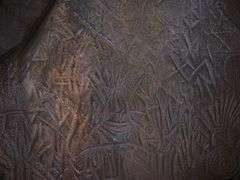
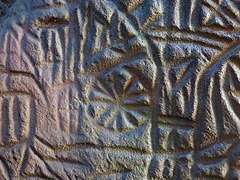
.jpg)
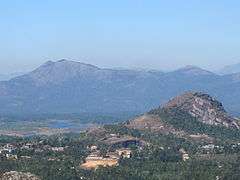 View of surroundings from Edakkal Caves
View of surroundings from Edakkal Caves- Medieval inscription
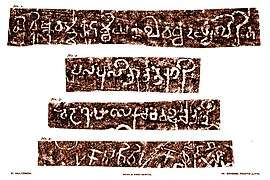 Prakrit Grantha inscription of Kadamba ruler Vishnuvarman (c. 5th-6th century CE)
Prakrit Grantha inscription of Kadamba ruler Vishnuvarman (c. 5th-6th century CE)
Kadamba inscription in Edakkal
- A short Tamil-Brahmi inscription, containing the word Chera ("Kadummi Pudha Chera"), was found at Edakkal.[3]
- An undated Prakrit-Grantha inscription of Kadamba king Vishnu Varma was recovered from the Edakkal Cave. The record, assigned to 5th or 6th century AD, shows the extension of Kadamba authority into Wynaad.[2][4]
See also
- Petroglyph
- Rock art
- Rock Shelters of Bhimbetka
References
- Shanmugam, P. 2014. 'Before the Common Era', in A Concise History of South India: Issues and Interpretations, ed. Noburu Karashmia, pp. 12–13. New Delhi: Oxford University Press.
- Fawcett, F. 1901. Notes on the Rock Carvings in the Edakal Caves, Wynaad. The Indian Antiquary vol. XXX, pp. 409-421.
- Subramanian, T. S. (9 February 2012). "Edakal cave yields one more Tamil-Brahmi inscription". The Hindu. ISSN 0971-751X. Retrieved 19 November 2018.
- Narayanan, M. G. S. Perumāḷs of Kerala. Thrissur (Kerala): CosmoBooks, 2013. 102-103.
External links
| Wikimedia Commons has media related to Edakkal Caves. |
- The Hindu (2006 article)
- Kerala Tourism (Official Website) - Edakkal Caves